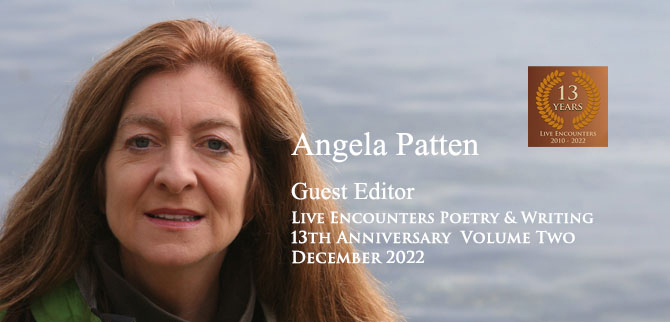Download PDF Here 13th Anniversary
Live Encounters Poetry & Writing Volume Two December 2022.
Hurry up please its time, Guest editorial by Angela Patten.

For years, my old friend Peter used to phone me on my birthday to tell me how many hours I had lived so far. At his memorial service earlier this year, I learned that he had done the same thing with other friends. We all admitted that it was disconcerting to consider the number of hours we had already lived, how much or how little we had accomplished, and how many more hours we might have left.
To mark this 13th anniversary of Live Encounters Magazine, I have been thinking about the concept of time.
Ever since people began to notice the regular movement of the sun and the stars, we have wondered about the passage of time. Humans have been devising ways to measure time for thousands of years, inventing water clocks, sundials, candle clocks, hourglasses, and large mechanical clocks which appeared in the towers of European cities in the early-to-mid-14th century.
I became fascinated with these mechanical devices after seeing the Prague Astronomical Clock and the Zytglogge in the Old City of Bern, Switzerland. In June of this year, I traveled to Wells in Somerset, England, to visit the Wells Cathedral clock. Dating from 1390, it is the second oldest working clock in the world. Its dials represent a geocentric view of the universe with the sun and moon revolving around a central fixed earth. On the quarter hour, the wooden figure of Jack Blandifer, the Quarter Jack, bangs the bell above him with his hammer and two more below him with his heels, setting the mechanism in motion and animating the jousting knights who charge at each other above the clock.
Like its European counterparts, the clock is a fusion of art, science, and craftsmanship, and it also serves as an allegory for the brevity of human life. The Prague Astronomical Clock registers an even more somber allegorical note with “The Walk of the Apostles,” an hourly show of moving apostle figures and other sculptures, including a skeleton that represents Death, striking a bell.
Before the proliferation of clocks, the alternation of day and night and the changing seasons determined most human activity. Our modern concepts of time and punctuality would have been inconceivable, not to mention absurd, to 14th century people. Even the fabulously decorated astronomical clocks of medieval Europe were not terribly accurate. Their initial purpose was to mark the hours of prayer. Ordinary people were not concerned with minutes so the clocks featured a 24-hour single-handed dial. As a result of new inventions in clockmaking in the latter half of the 17th century, more and more new clocks had 12-hour dials, with an additional minute hand.
Wells Cathedral, called the “most poetic of the English Cathedrals,” must have been an awe-inspiring spectacle for medieval peasants who could not read or write. The West Front of the gigantic building has around 300 of the original 400 statues on view, including two six-winged Seraphim who flank Jesus in the Judgement Day centerpiece at the top, supported by apostles, angels, and saints. On feast days like Palm Sunday, this theatrical vision would have been reinforced with trumpet music and singing to accompany processions of bishops and priests in their ostentatiously rich regalia.
When it comes to religious iconography, duplicity abounds. During my visit to Wells, I walked into the Cathedral grounds through Penniless Porch, a historic entryway where the poor were permitted to beg for alms, next door to the walled enclave of the Bishop’s Palace. I looked up to see a couple of irreligious pigeons canoodling in an alcove, unbothered by the passage of tourists or the passage of time.
In an essay on Dante, T.S. Eliot wrote that “Genuine poetry can communicate before it is understood.” In the elaborate façade of Wells Cathedral, which was originally painted in vibrant colors, the images communicated the power and promise of the Church and evoked a sense of wonder in the faithful even before they entered the building. Likewise, the power of poetry often lies in its suggestiveness and the seductive power of its imagery. While it may sometimes achieve timelessness, I’m glad to say it rarely promises redemption.
The passage of time has been a perennial theme of poetry, whether John Milton’s characterization of time as “the subtle thief of youth,” Robert Herrick’s exhortation to the virgins to “Gather ye rosebuds while ye may,” W.H. Auden’s “Stop all the clocks” lament, or Mary Oliver’s provocative question, “What is it you plan to do with your one wild and precious life?”
© Angela Patten
Angela Patten’s publications include four poetry collections, The Oriole & the Ovenbird (Kelsay Books 2021), In Praise of Usefulness (Wind Ridge Books 2014), Reliquaries (Salmon Poetry, Ireland 2007) and Still Listening (Salmon Poetry, Ireland, 1999), and a prose memoir, High Tea at a Low Table: Stories From An Irish Childhood (Wind Ridge Books 2013). Born and raised in Dublin, Ireland, she now lives with her husband, poet Daniel Lusk, in Burlington, Vermont, where she is a Senior Lecturer Emerita in the English Department at the University of Vermont.



So well written…. Thank you!
Fabulous.